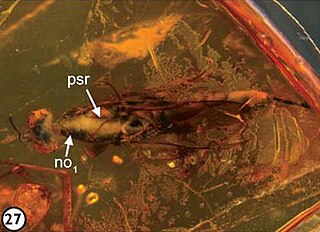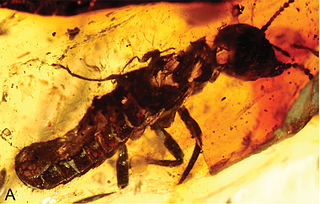
The Stephanidae, sometimes called crown wasps, are a family of parasitoid wasps. They are the only living members of the superfamily Stephanoidea. Stephanidae has at least 345 living species in 11 genera. The family is considered cosmopolitan in distribution, with the highest species concentrations in subtropical and moderate climate zones. Stephanidae also contain four extinct genera described from both compression fossils and inclusions in amber.

Hemerobiidae is a family of Neuropteran insects commonly known as brown lacewings, comprising about 500 species in 28 genera. Most are yellow to dark brown, but some species are green. They are small; most have forewings 4–10 mm long. These insects differ from the somewhat similar Chrysopidae not only by the usual coloring but also by the wing venation: hemerobiids differ from chrysopids in having numerous long veins and forked costal cross veins. Some genera are widespread, but most are restricted to a single biogeographical realm. Some species have reduced wings to the degree that they are flightless. Imagines (adults) of subfamily Drepanepteryginae mimic dead leaves. Hemerobiid larvae are usually less hairy than chrysopid larvae.

The Baltic region is home to the largest known deposit of amber, called Baltic amber or succinite. It was produced sometime during the Eocene epoch, but exactly when is controversial. It has been estimated that these forests created more than 100,000 tons of amber. Today, more than 90% of the world's amber comes from Kaliningrad Oblast of Russia. It is a major source of income for the region; the local Kaliningrad Amber Combine extracted 250 tonnes of it in 2014 and 400 tonnes in 2015.
Paleontology or palaeontology is the study of prehistoric life forms on Earth through the examination of plant and animal fossils. This includes the study of body fossils, tracks (ichnites), burrows, cast-off parts, fossilised feces (coprolites), palynomorphs and chemical residues. Because humans have encountered fossils for millennia, paleontology has a long history both before and after becoming formalized as a science. This article records significant discoveries and events related to paleontology that occurred or were published in the year 2004.
Paleontology or palaeontology is the study of prehistoric life forms on Earth through the examination of plant and animal fossils. This includes the study of body fossils, tracks (ichnites), burrows, cast-off parts, fossilised feces (coprolites), palynomorphs and chemical residues. Because humans have encountered fossils for millennia, paleontology has a long history both before and after becoming formalized as a science. This article records significant discoveries and events related to paleontology that occurred or were published in the year 1933.

Prionomyrmex is an extinct genus of bulldog ants in the subfamily Myrmeciinae of the family Formicidae. It was first described by Gustav Mayr in 1868, after he collected a holotype worker of P. longiceps in Baltic amber. Three species are currently described, characterised by their long mandibles, slender bodies and large size. These ants are known from the Eocene and Late Oligocene, with fossil specimens only found around Europe. It is suggested that these ants preferred to live in jungles, with one species assumed to be an arboreal nesting species. These ants had a powerful stinger that was used to subdue prey. In 2000, it was suggested by Cesare Baroni Urbani that the living species Nothomyrmecia macrops and a species he described both belonged to Prionomyrmex, but this proposal has not been widely accepted by the entomological community. Instead, scientists still classify the two genera distinctive from each other, making Nothomyrmecia a valid genus.
Fibla carpenteri is an extinct species of snakefly in the Inocelliidae genus Fibla. F. carpenteri is named in honor of the paleoentomologist Dr Frank Carpenter, for his vast knowledge and interest in Raphidioptera.

Metapelma archetypon is an extinct species of parasitic wasp in the Metapelmatidae genus Metapelma. The species is solely known from the Early Eocene Baltic amber deposits in the Baltic Sea region of Europe. Of the thirty seven described species in the genus Metapelma, M. archetypon is the only species known from the fossil record.

Diochus electrus is an extinct species of rove beetle in genus Diochus, the only definitive fossil species in subfamily Staphylininae. The species is known only from the middle Eocene, Lutetian stage Baltic amber found in the Blaue Erde deposits, Baltic region, Northern Europe.

Astreptolabis is an extinct genus of earwig in the Dermaptera family Pygidicranidae known from a group of Cretaceous fossils found in Myanmar. The genus contains two described species, Astreptolabis ethirosomatia and Astreptolabis laevis and is the sole member of the subfamily Astreptolabidinae.
Protostephanus is an extinct genus of crown wasp in the Hymenoptera family Stephanidae known from an Eocene fossil found in the United States of America. The genus contains a single described species, Protostephanus ashmeadi placed in the stephanid subfamily Stephaninae.

Prostylotermes is an extinct genus of termite in the isopteran family Stylotermitidae known from two Eocene fossils found in India. The genus contains a single described species, Prostylotermes kamboja.
Zophotermes is an extinct genus of termite in the Isoptera family Rhinotermitidae known from two Eocene fossils found in India. The genus contains a single described species, Zophotermes ashoki placed in the subfamily Prorhinotermitinae.

Yantaromyrmex is an extinct genus of ants first described in 2013. Members of this genus are in the subfamily Dolichoderinae of the family Formicidae, known from Middle Eocene to Early Oligocene fossils found in Europe. The genus currently contains five described species, Y. constrictus, Y. geinitzi, Y. intermedius, Y. mayrianum and Y. samlandicus. The first specimens were collected in 1868 and studied by Austrian entomologist Gustav Mayr, who originally placed the fossils in other ant genera until the fossils were reviewed and subsequently placed into their own genus. These ants are small, measuring from 4 to 6 mm in length and can be characterized by their trapezoidal shaped head-capsules and oval compound eyes that are located slightly to the rear of the capsules midpoint, with no known ocelli present.

Elephantomyia (Elephantomyia) baltica is an extinct species of crane fly in the family Limoniidae. The species is solely known from the Middle Eocene Baltic amber deposits in the Baltic Sea region of Europe. The species is one of six described from Baltic amber.
Serphitidae is a family of microscopic parasitic wasps known from the Cretaceous period.

Paraneuretus is an extinct genus of formicid in the ant subfamily Aneuretinae known from fossils found in Asia and Europe. The genus contains three middle to late Eocene age species, Paraneuretus dubovikoffi, Paraneuretus longicornis, and Paraneuretus tornquisti.

Electromyrmex is an extinct genus of ants in the formicid subfamily Dolichoderinae. The genus contains a single described species, Electromyrmex klebsi and is known from a group of Middle Eocene fossils which were found in Europe.

Embolemus is a genus of wasps belonging to the family Embolemidae. There is debate regarding the status of the genus named Ampulicomorpha by Ashmead in 1893, generally considered now to be a junior synonym of Embolemus (e.g.,), as a few authorities dispute this (e.g.,).
This paleoentomology list records new fossil insect taxa that are to be described during the year 2022, as well as notes other significant paleoentomology discoveries and events which occurred during that year.













